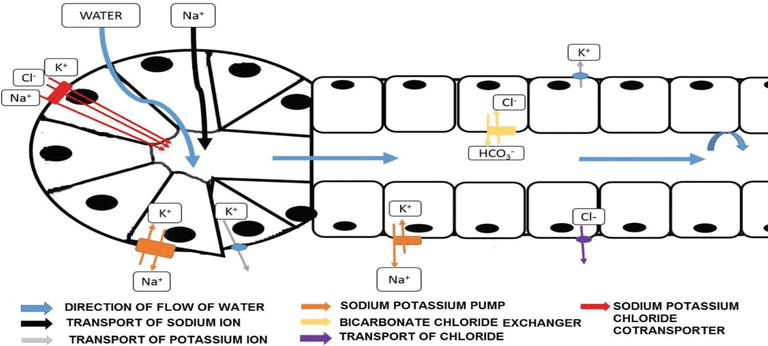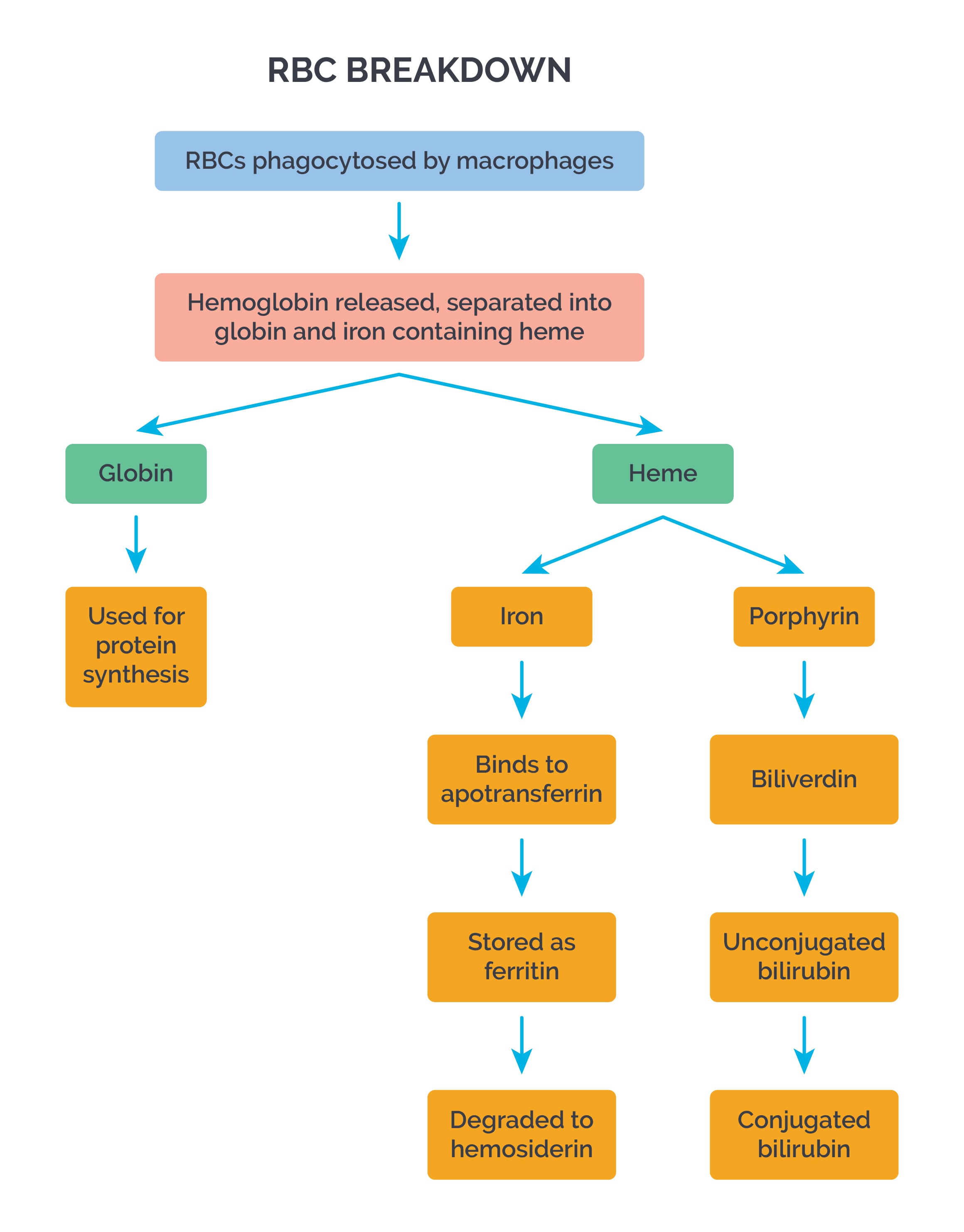Various enzymes break down food components into molecules the intestines can easily absorb. The following table shows the major enzymes helping in digestion:
| Enzymes present in saliva | ||
| Enzyme | Substrate | Digestion Products |
| Lingual lipase | Triglycerides | FFA*,mono and diglycerides |
| Salivary amylase | Polysaccharides | Di and trisaccharides |
| Gastric enzymes from chief cells of the stomach | ||
| Gastric Lipase | Triglycerides | FFA and monoglycerides |
| Pepsin | Proteins | Peptides |
| Small intestinal brush border enzymes | ||
| Enteropeptidase | Trypsinogen | Trypsin |
| Lactase | Lactose | Glucose and galactose |
| Maltase | Maltose | Glucose |
| Nucleosidases and phosphatases | Nucleotides | Nitrogen bases, phosphates and pentoses |
| Peptidases | Dipeptides and amino acids | Peptides and amino acids |
| Sucrase | Sucrose | Glucose and fructose |
| Pancreatic enzymes** | ||
| Carboxypeptidase | Amino acids at the carboxyl end | Amino acids |
| Chymotrypsin | Proteins | Peptides |
| Elastase | Proteins | Peptides |
| Nucleases | DNA and RNA | Nucleotides |
| Amylase | Polysaccharides | Alpha dextrins, maltose, maltotriose |
| Lipase | Triglycerides | FFA and monoglycerides |
| Trypsin | Proteins | Peptides |
*FFA stands for free fatty acids.
**Pancreatic enzymes are secreted in inactive zymogen form and must be activated first; exceptions are pancreatic amylase, lipase, and nucleases.
Secretion and composition of saliva: Salivary glands are composed of an acinus where initial saliva is produced. This leads to a short intercalated duct, which then leads to a striated duct lined by ductal cells. Myoepithelial cells help to move the saliva through the ducts.

Parotid glands secrete more watery saliva and produce the bulk of saliva during tasting and chewing food. Parasympathetic innervation to the parotid gland comes from the glossopharyngeal nerve (CN IX) originating in the inferior salivatory nucleus and is relayed to the gland by the auriculotemporal nerve. Sublingual and submandibular glands are supplied by the chorda tympani branch of the facial nerve and secrete a mixed serous and mucinous saliva which has a greater contribution to the resting or “background” saliva that coats the oral surfaces for most of the day and night between episodes of stronger stimulation. Normally, saliva is hypotonic, with a higher K+ and HCO3- but lower Na+ and Cl- concentration than plasma. The intercalated duct cells add lysozymes and lactoferrin to the saliva. At higher flow rates saliva resembles plasma and also has higher HCO3- concentration compared to lower flow rates.
The salivary glands have both sympathetic and parasympathetic innervation, and both of the systems result in increased salivary secretion, although the composition may vary. M1 and M3 are the main parasympathetic receptors, while alpha and beta are the main sympathetic receptors on the salivary glands. Parasympathetic stimulation causes increased IP3 and calcium, while sympathetic stimulation causes increased cAMP levels.
Factors affecting salivary secretion: Alpha adrenergic receptor stimulation results in high protein secretion while beta adrenergic or cholinergic stimulation results in lower protein but high water and electrolyte secretion. Substance P stimulates alpha adrenergic and cholinergic secretion of saliva. Copious watery saliva is secreted in response to parasympathetic stimulation and thicker saliva in response to sympathetic stimulation. Antidiuretic hormone facilitates water reabsorption by striated duct, aldosterone causes increased sodium reabsorption by striated duct, testosterone and thyroxine increase salivary secretion . In cystic fibrosis, saliva contains increased calcium levels, elevated levels of Na+, Cl- and a decrease in flow rate.
Gastric secretion: The parietal cells secrete HCl and intrinsic factor; the chief cells secrete pepsinogen; G cells secrete gastrin while the mucous cells in the oxyntic glands secrete mucus and pepsinogen. Low pH of the stomach helps to convert inactive pepsinogen to active pepsin.
HCl secretion: The apical membrane of the parietal cell faces towards the gastric lumen while the basolateral membrane is adjacent to the blood vessels. Apical membrane contains the H+K+ ATPase and Cl- channels. Basolateral membrane has Na+K+ ATPase and Cl-HCO3- exchanger. The enzyme carbonic anhydrase converts CO2 from the cell to H2CO3 which then dissociates into H+ and HCO3-. By an active process, H+ is secreted into the lumen by H+K+ATPase. HCO3- enters the bloodstream through the basolateral membrane via Cl-HCO3- exchanger, leading to post meal “alkaline tide”. Cl- diffuses through the apical Cl- channels into the gastric lumen ultimately combining with H+ to form HCl. H+ secretion is stimulated directly by ACh, histamine and gastrin and indirectly by GRP (as it increases gastrin secretion). They show potentiation i.e. the combined effect of two factors is greater than the sum of the effect of each factor acting alone. In addition, distension of the stomach, products of protein digestion, alcohol, caffeine and acts of chewing, swallowing and conditioned responses to smells increase HCl secretion. Somatostatin inhibits HCl secretion by activating Gi protein leading to inhibition of adenylate cyclase and decrease in intracellular cAMP and also by inhibiting the release of histamine and gastrin. The stomach protects itself from the effects of its own pepsin and HCl by producing mucus, HCO3-, prostaglandins and growth factors. In gastric ulcers, the net H+ secretion is low while in duodenal ulcers the H+ secretion is higher than normal.
| Factor | Mechanism |
| Acetylcholine | Stimulation of M3 receptors; increase in intracellular IP3, DAG, calcium |
| Histamine | Acts through H2 receptors; increase in intracellular cAMP. |
| Gastrin | Acts through CCK B receptors on parietal cells; increases intracellular IP3 and calcium. |
Pancreatic secretion: Exocrine pancreas secretes enzymes in zymogen form. Parasympathetic stimulation increases while sympathetic stimulation inhibits pancreatic secretion. Pancreatic juice is high in Na+, Cl-, K + and HCO3-. HCO3- helps to neutralize H+ from the gastric chyme, facilitating the action of pancreatic enzymes. Secretion of HCO3- into the pancreatic lumen is associated with absorption of H+ into the pancreatic veins which helps neutralize the post-meal alkaline tide. At higher flow rate, the pancreatic juice has a higher concentration of HCO3- and lower Cl-. Opposite effects are seen at lower flow rates. Na+ and K+ concentrations remain constant and are similar to plasma levels. Secretin stimulates HCO3- rich pancreatic secretion.
Liver, gallbladder and bile: Bile is being continuously produced by the hepatocytes. It is composed of 50% bile acids and bile salts, bile pigments, cholesterol, phospholipids, electrolytes and water. Cholic acid and chenodeoxycholic acid are the primary bile acids. They are dehydroxylated by intestinal bacteria to form secondary bile acids deoxycholic and lithocholic acids. The liver conjugates the bile acids with amino acids taurine and glycine to form bile salts, making them more water soluble in the process. Bile salts emulsify dietary lipids and form micelles containing digested lipids. The major bile pigment is bilirubin. It is formed by reticuloendothelial cells from the breakdown of hemoglobin. Bilirubin is transported to the liver bound to albumin in the blood. The enzyme UDP glucuronyl transferase in the liver conjugates bilirubin with glucuronic acid to form bilirubin glucuronide which is secreted into bile. Once in the intestine, bilirubin is set free and converted to urobilinogen by intestinal bacteria. Some of the urobilinogen is recirculated to the liver, some of it is converted to urobilin and stercobilin which give urine and feces their yellowish colors respectively. Secretin stimulates secretion of electrolytes and water in the bile.

Bile is stored in the gallbladder till CCK causes ejection of bile by contraction of the gallbladder and relaxation of the sphincter of Oddi. The longer period of time that bile is stored in the gallbladder, the more it is concentrated as water and ions gets absorbed.
The liver performs many vital functions in the body. It plays an important role in carbohydrate, fat and protein metabolism. It converts toxic ammonia to urea that can be excreted. It is the site of detoxification reactions. It synthesizes almost all plasma proteins including albumin and clotting factors.
Sign up for free to take 21 quiz questions on this topic